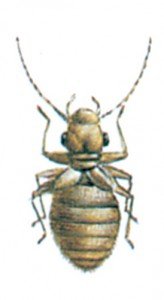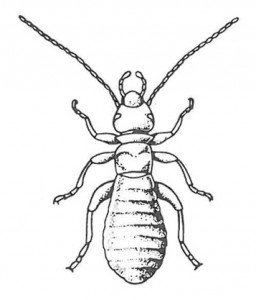

Latin: Psocoptera or Copeognatha.
Booklice is an insect family, which in Europe includes several hundred species. They are small insects with rather broad heads and smooth skin. They are rather small, no more than 1 – 2 mm in length and the species may only be determined under a microscope. Most are pale and yellowish, but there are also a few dark coloured species. Species of booklice living in the wild usually have wings and live near lichen and moss. The indoor species have very small wings or no wings at all. Only a few of the dark coloured species have real, functional wings. When this kind of winged booklice occurs in foods, it is not uncommon to see the loose, torn wings be distributed among the booklice in the product. The indoor booklice prefer damp, dark places and they are most common in basements, attics and damp walls. This is among other factors due to the fact that they do not tolerate dehydration and they feed on the moulds that thrive in moist conditions on walls. The same fungi that cannot be seen with the naked eye, is also available, along with booklice, in damp furniture, on damp paper and especially in damp hay and straw. In new buildings there are usually many booklice the first 2 – 3 years, but their numbers decrease as the building becomes dry over time. In older, dry houses they tend to live under sinks, in places where the back of a piece of furniture positioned against a cold outer wall and in bathrooms. In autumn, when the humidity level is higher indoors, they come back and graze on the invisible fungal growth, which is also a result of the autumn humidity. At Christmas time it is usually too dry for them to live out in the open and the rest of the year until next fall, they live quietly in hidden places.
In kitchens booklice are mainly found in starches, especially flour and grain products. The classic consumer situation is that booklice are all over a bag of flour and then perhaps in everything else in the vicinity. It is also not surprising that booklice only reproduce all year when the appropriate warmth and humidity are present. Each female booklice can lay a few hundred eggs. The development from egg to adult only lasts one month. Booklice offspring look like adults, but are slightly smaller.
Booklice in flour bags has often led to discussions between consumers and sellers. Booklice are quite harmless and since they cannot dig into flour, they only exist on the surface. Flour with many booklice should be discarded. Not because of the presence of booklice themselves, but because their presence indicates that the item may be slightly mouldy and with unfamiliar fungi and it is therefore not worth the risk.
When a fresh product contains booklice when the bag is first opened, it is hardly the consumer’s own booklice that are present. It is different when a bag of flour has been in a cabinet for several weeks, opened or unopened, and it then turns out to be infested with booklice. Here one can not immediately determine whether it is booklice from a retailer’s warehouse or perhaps even earlier distribution or whether it is the customer’s own booklice that have found the slightly damp flour.

It is considered good business acumen that products infested with booklice are replaced by equivalent new ones, so the customer gets the opportunity to see that these products generally do not contain booklice. At the same time the retailer investigates whether other parts of the same party are infested.
Booklice are exterminated by removing moisture from the premises and goods by means of dehydration, ventilating, heating and by isolating cold and therefore damp walls. Treatment of damp walls with a mould-and mildew-killing agent can sometimes give good results, but often it is necessary to completely remove moisture. Booklice are ubiquitous and will appear in places where conditions are favourable to them. To exterminate large populations of booklice, treatment with ordinary insecticides for domestic use can be used, for example, with pyrethrin. Supplement this treatment with vacuuming. It helps for a short period, allowing time to implement the actual fight, which is to remove moisture.




